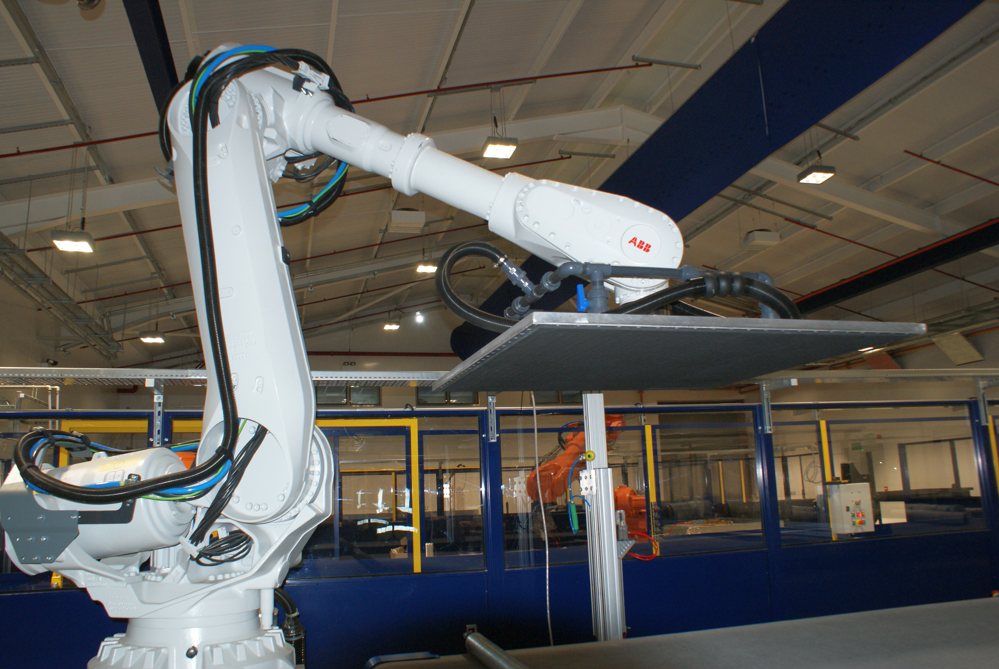Step up to the plate and automate!

ABB robots are helping Solvay’s research centre in Heanor, Derbyshire to open up new possibilities for high volume composites production and find ways of reducing the cost and time of composites production.
Four ABB robots are helping a leading manufacturer of multi-speciality chemicals to develop new ways of expanding the use of lightweight composites for adoption in industrial applications.
Installed at Solvay’s application centre in Heanor, Derbyshire, the robots are being used to help test, refine and demonstrate methods for reducing the cost and time associated with the creation of composite materials and composite material parts for use in high volume production markets, such as the automotive, aerospace, mass transportation, marine and renewable energy sectors.
Solvay is a leading supplier of composite materials, process consumables and tooling for industries demanding rapid response and short lead-times. Representing a $13 million investment, the centre is dedicated to finding new ways to apply mass production technology to the manufacture of composite material formats and components to enable them to be used more widely throughout industry.
Despite the benefits that composite materials can bring, a challenge has been the cost and time incurred in their manufacture as well as conversion to components.
“While carbon fibre-epoxy composites offer an ideal alternative to traditional alloys, they have been expensive to produce and have historically required long manufacturing times,” says Richard Hollis, applications research and technology engineer at the centre. “As a result, their use has tended to be limited to applications where cost is less of an issue, for example Formula One, supercars, racing yachts and aircraft, where improving performance and speed and reducing fuel consumption are key requirements.”
To reduce the cost and time of manufacture, the centre has developed new materials such as rapid cure thermoset prepregs and HP-RTM resin systems.
In a prepreg manufacture process, the fibres are impregnated with the resin, with the finished composite being supplied in a roll format to the part manufacturer. In an HP-RTM process, the part manufacturer buys the reinforcement and the resin uncombined, and the fibre gets impregnated in a closed mould tool under extreme pressures.
The centre’s aim is to find ways to optimise composites manufacturing processes using the latest automated production technologies sees ABB’s robots being used in various integrated cells alongside equipment from other manufacturers.

“Our main goal is to find ways to produce composites at a higher rate and affordability,” says Hollis. “Having robots in our centre enables us to develop new product formats and processing technologies allowing us to demonstrate our ability to automate the part manufacturing for many industries where high-volume production of composite structures was not previously deployed or even possible.”
Two of the robots work independently in separate processes. The IRB 6700 is used in a process involving the implementation of localised slashing and cross-plying of UD prepreg material. During this process, a roll of prepreg material is first cut into squares with an ultrasonic knife. Fitted with a vacuum end effector, the robot picks up a square from one roll and lays it at a 90° angle on top of a second roll of material to create a 0/90 cross-plied prepreg. This was historically a manual, time-consuming process.
The second IRB4600 is integrated with a numerically-controlled cutting machine, which takes the prepreg roll format created within the automated cross-ply cell. The cutting machine cuts out ply geometries associated with an automotive component and presents them to the robot. The robot picks up the cut pieces, up to eight pieces together, and deposits each piece in turn to create a 2D composite ‘blank’. This blank is subsequently cured and trimmed using a robot.
The remaining two robots – the other IRB 4600 and IRB 6700 – are used in a cell handling trimming of dry fibre preforms. Integrated together on a track motion system, the two robots are used to handle and trim preformed parts prior to the curing stage of manufacture.
In developing the applications for the robots, the aim was to find ways that they could be used to deliver improved speed, accuracy, repeatability and quality over manually operated processes.
“Our aim has been to find ways to use automation to achieve the greatest value adding processes and time savings in collaboration with our customers for them to adopt in their own processes,” Hollis concludes. “Capable of repeatable performance and high accuracy, even at high speeds, robots can play a key role in automated composite production and handling processes.”
https://new.abb.com/products/robotics








